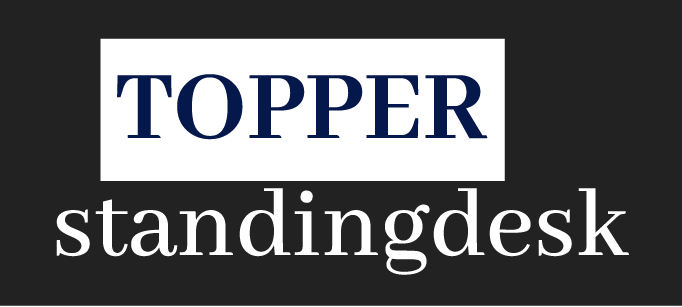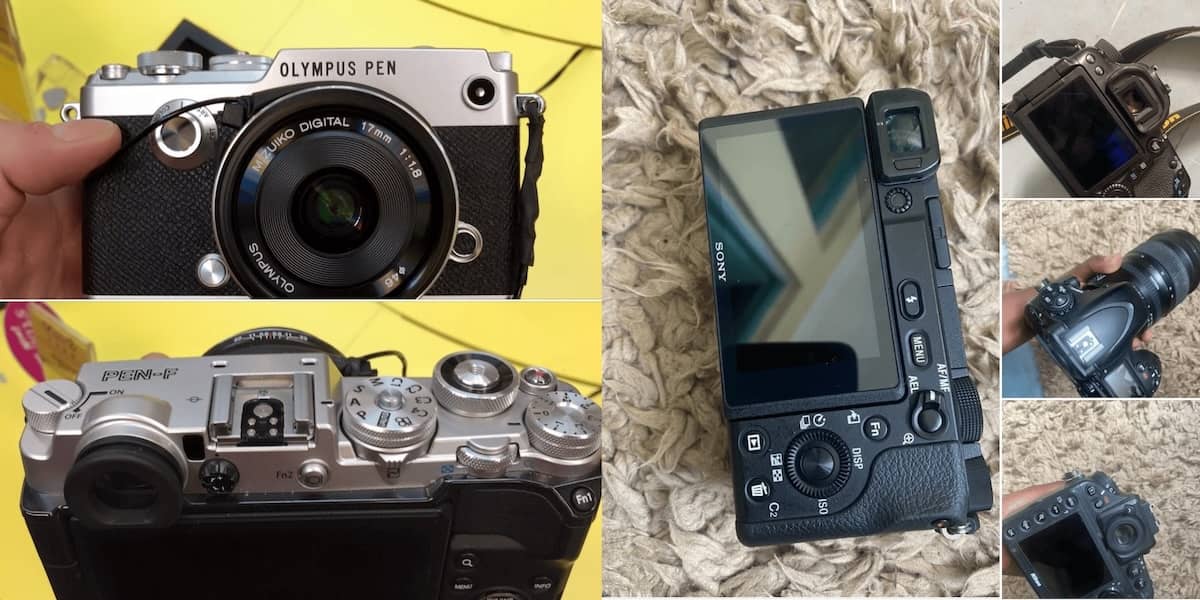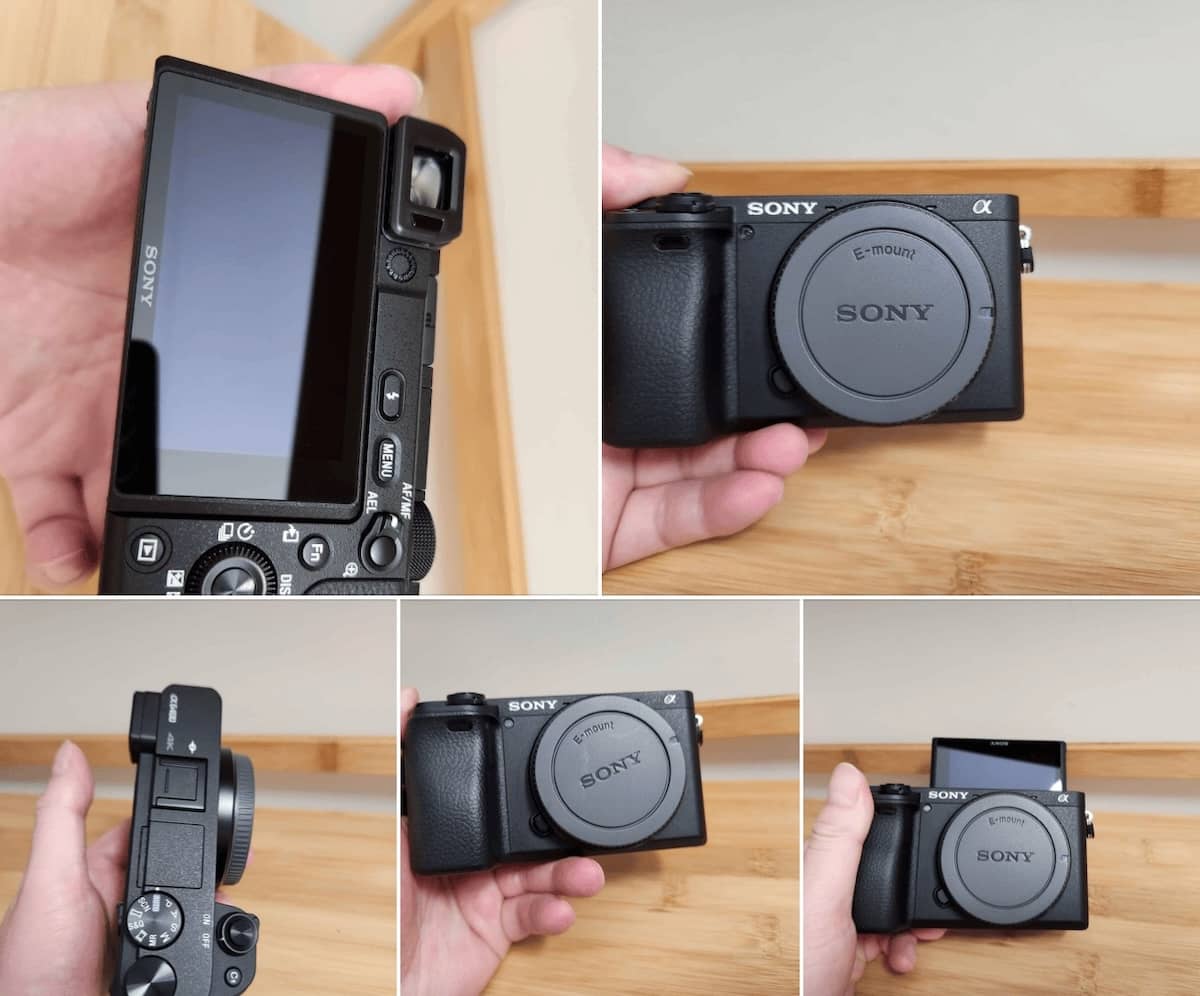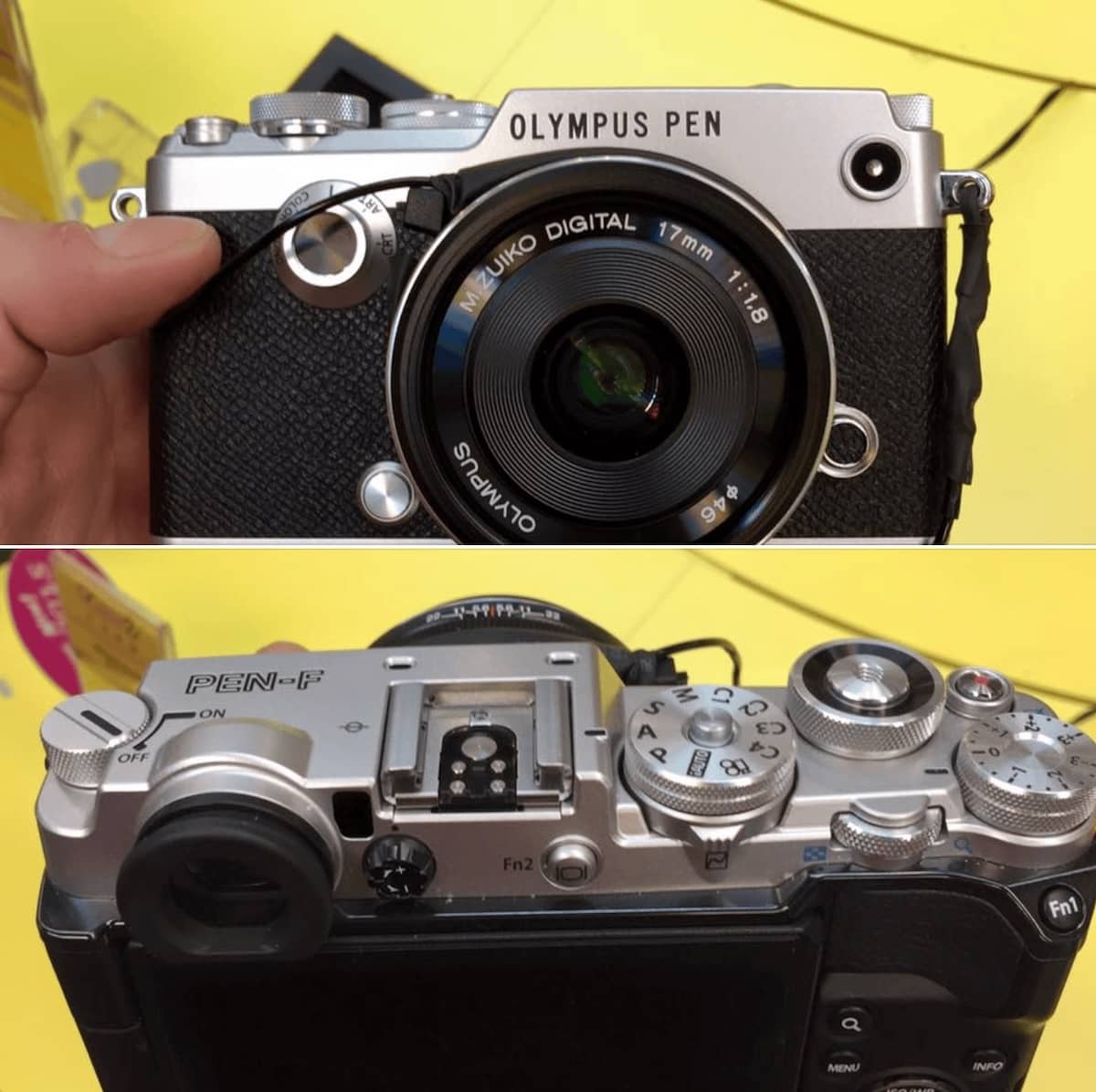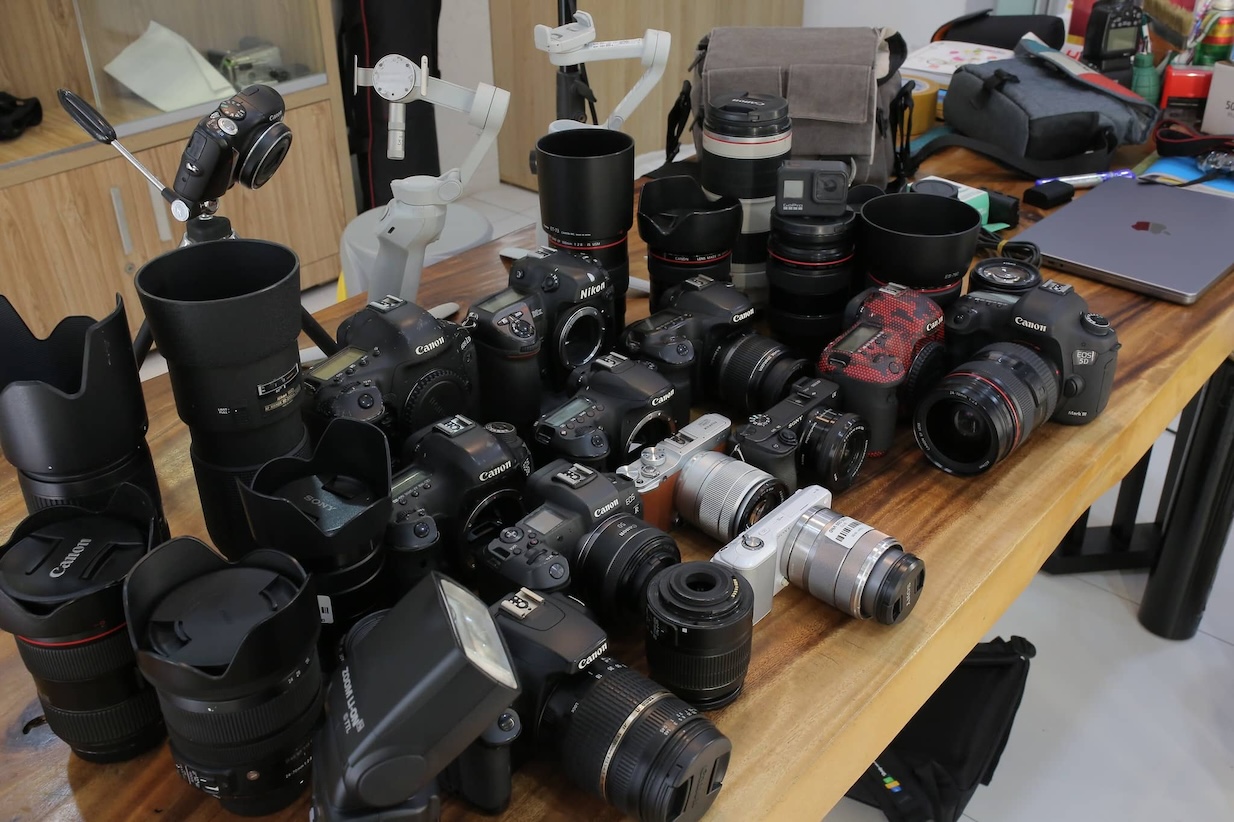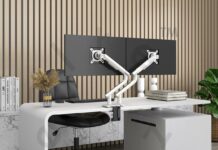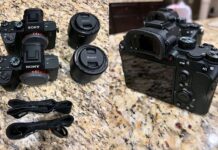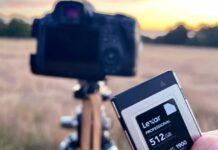Price isn’t always an issue for professionals. Quality always comes first and foremost, especially when it comes to equipment. This also applies to professional photographers who take photographs for a living.
There are many cameras available, but only a few are considered the best options for this profession. However, before you go too far in your search for the best options, you should be aware of the factors to consider before buying one. Though you should understand them already as a professional, there are many general users who don’t, yet want to know about them, and this article is intended to help all types of users understand this subject so they can find the camera they need.
Quick List Recommendations
Standingdesktopper's pick
- Let’s start with the buyer’s guide first
- The best cameras for photography – Everything we recommend
- Olympus OM-1 Mark II Mirrorless MFT Camera Body
- Leica Q2 Reporter Mirrorless Fixed-Lens Camera
- Sony A6000
- Sony A6400
- Sony A7III
- Sony A7R IV
- Canon R50
- Canon EOS R
- Canon R8
- Nikon D3500, a Lightweight Casual DSLR
- Fuji X-S20, the Enhanced APSC
- Fuji X-T30
- Nikon D850 DSLR Camera Body
- Canon EOS R5 Mark II Mirrorless Camera Body
- Fujifilm X-T5 Mirrorless APS-C Camera Body
- Sony Alpha 9 III Mirrorless Camera Body
- Panasonic Lumix S5II Mirrorless Camera Body
- Nikon Coolpix P1000 Point-and-Shoot Superzoom
- Nikon Z7 II Mirrorless Camera Body
- Canon R3 EOS Mirrorless Camera Body
- An Introspective Final Frame
Let’s start with the buyer’s guide first
- Camera Type
DSLR and mirrorless cameras are the two most common types of cameras used by professionals. Though mirrorless cameras appear to fit them better due to their lighter weight and smaller size than DSLR cameras, this doesn’t mean that you should overlook the quality of DSLR cameras. The image quality produced by this model is excellent for a moving object, though the object must be within the AF point coverage area. Mirrorless models, on the other hand, offer greater flexibility due to the smaller size of the camera body, as well as the ability to autofocus on any area of the frame with just a single press of the touchscreen.
- Sensor Size
For those unfamiliar with the subject, sensor size determines the quality of the image captured by the camera. The larger it is, the better the image quality will be. This is because they have larger pixels, which affects low-light performance, noise reduction, and all of the image information that will be translated into the image. There are various sensor sizes available in any type of camera, ranging from the largest, which is medium format, to the smallest, which is 1-inch type. To find the best camera to suit your needs, you should first understand the requirements. Of course, having the biggest sensor available is always the desired option, but it also comes with a cost. Cameras with smaller sensors, on the other hand, are generally less expensive and, due to their compact size, are better suited for those with high mobility.
- Megapixels
We are sure you have heard this many times before, but for those who have not, this is the measurement of the resolution for the photos that are taken. A single picture contains a million pixels for each megapixel. The denser the pixels are, the more detailed the image will be. In general, higher resolution results in better image quality. However, sensor size also plays an important factor that should not be overlooked in order to produce a high-quality image.
- Battery Life
If you work as a professional photographer, you may be required to use your camera for several hours, if not days. As a result, battery life should be another consideration. It is pointless to have a camera with excellent specifications if it has the worst battery life. Though how long you need the battery to last is a personal preference, it is always preferable to select the one which the battery life lasts for a reasonable amount of time. Because of the long battery life, you don’t need to buy a spare battery while working or taking casual photos with the camera, even if most professionals do.
- Price
When buying any item, price is always one of the factors to consider. Because cameras are usually expensive, you should always consider your budget. You need to be aware that you might require accessories in the future, such as memory cards, lenses, and other items that will cost you money. Unless money is not an issue for you, you should always consider the total price of the camera and all the accessories required to fit your budget.
The best cameras for photography – Everything we recommend
A subjective matter at the best of times, who’s to say what the best camera for photography truly is? Take our staffers as an example of the struggle to single out one ‘best-of’ model. Their cameras are picked from a wide variety of brands, each chosen for their unique strengths.
Our oldest reviewer is a fan of sporting events, someone who appreciates certain DSLR features. Fast mechanical shutter speeds that freeze-frame a single moment of adrenaline-fueled action, that’s his weekend passion. Someone else on the team is a bit of an artist; he’s a seeker of photographic beauty, capturing fine details in low-light scenes. Always on the move, he slips into the late evening with his mirrorless Sony ready, hiding in the shadows, hopefully not scaring ladies who are nearby. Don’t worry, he’s harmless.
With so many options on the market, choosing the ‘best’ camera is less about finding a single perfect model and more about discovering the model that suits your unique style and needs, which is just how our diverse team of reviewers feel about the issue.
So instead of trying to narrow your choice down to one fabled ‘unicorn’ of a camera body, a device that doesn’t exist, we’ve decided to curate a list of the top 20 cameras that excel in various areas of your photographic journey.
Let’s get started.
Olympus OM-1 Mark II Mirrorless MFT Camera Body
The OM-1 Mark II is first on the list because it’s the complete package, a high performance micro four thirds camera body that’s the cornerstone of the Olympus OM System lineup. Budget conscious buyers can look out for deals on the previous generation Olympus OM-1, but we’ll be sticking with the Mark II successor.
A test model, complete with an M.Zuiko ED 150-600mm F5.0 – 6.3 IS lens was laid out for the review, and the OM-1 Mark II didn’t disappoint. A 5-axis built-in image stabilization system kept objects steady at the telephoto end of the zoom. Better yet, a 1053 point AF system paired phase detection with contrast technology to assure a rock-solid lock, rendering the sharply focused light on a 20.4 Megapixel stacked BSI live micro four thirds CMOS sensor.
Notable features include the integrated LiveGND filter, a 5760K dot electronic viewfinder, an ISO range of 200 – 102,400, a lightning fast 1/8000th second shutter speed, and a number of useful shooting modes. A 3.0” vari-angle touch LCD and numerous art filters underscore the camera’s photographic credentials, positioning it as pro-level gear with beginner-friendly intentions included.
Tester Inside Scoop – It’s a lightweight micro four thirds mirrorless camera with weatherproof strengths. Improvements over the previous generation have been made to the digital buffer, so expect 120 fps of RAW image bursts. There’s Aperture Priority and Full Manual modes on the command dial to keep detail-oriented pros on their toes, too.
Let’s not forget Wi-Fi connectivity, dual SD cards, and 4K 30p video shooting modes, either. However, the micro four thirds sensor can’t pull in as much detail as a full-frame sensor. Overall, though, this is a contender for best outdoor mirrorless MFT shooter.
Leica Q2 Reporter Mirrorless Fixed-Lens Camera
If there’s a best camera for photography that offers all the quality in the world while retaining pocketable dimensions, that would have to be the Leica Q2. For starters, at 5.12” long and just over 3” in width, the German engineered compact will fit in a pocket, but just barely. For a premium product like this, we recommend a carrying case, like the Protector Q2, leather. Other than that, size doesn’t affect performance, not with a full-frame 47.3 Megapixel CMOS sensor operating at peak efficiency.
Outperforming its physical size, the Leica Q2 shoots razor-sharp stills with 14-bit color depth. For video performance, 4K is standard, shot at 30p or 24p, filming richly detailed scenes with cinematic quality. One potential drawback, the Leica Summilux lens, featuring a 28mm f/1.7 optics, is a fixed component. Even so, it’s the perfect portable camera for wandering an evening street in Rome or Florence, snagging renaissance images and depth-of-field isolated antiquities in the low light.
The IP52 ingress protection rating is a strength, then there’s the Reporter only Aramid fiber armoring to really beef up its frame. An inbuilt image stabilization system for even crisper pictures, the true-to-life OLED viewfinder, 3.69 million dots worth, composes super-steady shots. If the photographer in question prefers lining up a shot via the monitor, as our test staffer did, there’s a 3.0” monitor on the rear of the camera equipped with touch controls.
Tester Inside Scoop — Autofocus performance was outstanding because of a 0.15 second focus lock. A brief look at the specs showcased selectable 225 field single-zone locking, proving itself reliable with different subject types in wildly alternating lighting conditions. Image-wise, crisply focused shots are packed with vibrant color and details; that’s the ISO 50 – 50,000 sensitivity at work.
While stuck with a fixed focal length, the Leica Q2 had to be on this list due to a massive size-to-performance ratio. It simply excels in situations where portability is essential but image quality can’t be sacrificed.
Sony A6000
 Sony Alpha a6000 Mirrorless Digital Camera 24.3MP SLR Camera with 3.0-Inch LCD (Black) w/16-50mm Power Zoom Lens
Sony Alpha a6000 Mirrorless Digital Camera 24.3MP SLR Camera with 3.0-Inch LCD (Black) w/16-50mm Power Zoom Lens
Since this camera is nearly a decade year-old, the price has dropped significantly.
Because of having useful features, this is one of the best cameras to use even for a professional.
Sony A6000 was released in 2014, which has been almost a decade after its initial release this article is written. Despite its age, it remains a relevant camera for fast-paced occasions such as weddings, graduations, and other events. It can also be used for sport photography, though this is not fully recommended. Autofocus performance is what makes it outstanding for these types of photography.
With 179 depth-aware phase-detect points and 25 contrast-detect points, the a6000’s autofocus system performs well in speed, precision, and coverage. The AF system delivers exceptional performance by leveraging the 24MP sensor’s ability to identify the focal point, whether it is your primary subject or a recognized face. The top class continuous autofocus capabilities ensure consistent focus on your subject, even when moving, while capturing moments at a rapid 11 frames per second. This ability extends to video recording, with little to no focus hunting. The extensive autofocus frame coverage allows your subject to freely move around the scene, setting a new standard in autofocus technology.
Even though the A6000 only has an APSC sensor, when paired with fast lenses like the 50mm 1.8 OSS or 35mm 1.8 OSS, it can produce stunning images with nice bokeh to separate the subject from the background. In low-light situations, a faster shutter speed can also be used to reduce noise. Even though it does not have a full-frame sensor, it is a very good camera in this regard.
The A6000, like other mirrorless cameras, has battery life issues. It is rated at 360 photos (CIPA), but in practice, you can get 500-750 photos out of a single battery without using the built-in flash.
Sony A6400
 Sony Alpha a6400 Mirrorless Camera
Sony Alpha a6400 Mirrorless Camera
If you have the money, you should consider the A6400, which is an upgraded version of the A6000. It is twice as expensive as the Sony A6000, but it has so many useful features that even professionals love that it is the best value for money.
The reason for this is that the A6400 is equipped with some features from Sony’s flagship lineup, such as real-time autofocus that is extremely accurate and sticky to both humans and animals. It also has excellent object tracking autofocus for tracking cars, planes, boats, and other fast-moving objects. The autofocus system in this camera is extremely reliable. Unlike the aA6000, it is easier to use, simply by touching the screen.
This autofocus feature is also available in video mode. The real-time AF system is more reliable and faster than Canon’s dual pixel AF system. What is more interesting is the autofocus can be used in 4K video recording mode. It is a lot of fun to use, and a great choice for self-vlogging and content creation. If you intend to create videos in the future, the A6400 is still a decent purchase at its price.
The A6 series cameras are all APSC, A6400 is no different. It has a smaller sensor than the flagship model and relatively poor noise performance when compared to a full-frame camera. It can, however, be corrected by using a fast lens, which is widely available in the market. Combining the A6400 with 1.2 or 1.4 lenses from Samyang, Sigma, or even Sony G Master Lenses creates a powerful kit that even professionals will want to use.
The battery life of this camera is comparable to A6000. It has a 410 CIPA rating, but in practice, it can take 700+ photos before the battery runs out. There is a standby time setting that can be used to extend the battery life. Set it to 10 seconds and notice a significant difference in battery life when compared to 30 seconds or more.
Sony A7III
 Sony a7 III (ILCEM3K/B) Full-frame Mirrorless Interchangeable-Lens Camera with 28-70mm Lens with 3-Inch LCD, Black
Sony a7 III (ILCEM3K/B) Full-frame Mirrorless Interchangeable-Lens Camera with 28-70mm Lens with 3-Inch LCD, Black
For various reasons, professionals prefer full-frame cameras for their work. You can get a reliable camera that can be used for both photography and videography. This camera can do both, thanks to its in-body 5-axis image stabilizer.
This camera offers numbers of features that cover a wide range of photography genres such as portraits, landscapes, streets, weddings, events, and even sports for both enthusiasts and those who are just starting out as photographers. The A7III has a 24-megapixel sensor, which is large enough for various of applications such as landscape photography. The full-frame sensor of the camera also allows for better subject separation than its APSC counterpart.
Sony A7III has a high dynamic range and excellent low-light performance because of the new BSI sensor. This camera is also ISO-independent. This means that in editing programs like Lightroom or Photoshop, you can increase exposure and shadow levels without making more noise. This feature is especially useful when shooting both bright and dark scenes in a single image.
Another great feature of A7III that many professionals like is the dual SD card slot. It enables new photographers to have a backup of important photos and videos in the event that the main SD card fails, which appears to be possible. Because of the larger battery capacity, Sony A7III easily outperforms A6000 and even A6400 in long photography sessions. With a capacity of 710 shots (CIPA), it can practically last the entire day of a wedding without the need for a battery change.
Even though the autofocus system is not as good as A6400’s, it is still excellent when compared to older cameras or even DSLR. It is reliable, fast, and enjoyable to use. Overall, Sony A7III is highly recommended for enthusiasts or those who are just starting out as professionals.
Sony A7R IV
 Sony Alpha 7 IV Full-frame Mirrorless Interchangeable Lens Camera
Sony Alpha 7 IV Full-frame Mirrorless Interchangeable Lens Camera
Commercial, landscape, and property photographers typically require high-resolution cameras for large-format prints. Otherwise, the details of the image will appear muddy, pixelated, and unpleasant to look at. Regular users, on the other hand, can also benefit from a high-megapixel sensor for cropping and capturing more details.
Sony A7R IV is one of the most highly recommended cameras for this specific purpose. The ‘R’ model in A7 stands for Resolution, offering outstanding over 60-megapixels sensor. It offers several improvements over the A7III and A7R III.
One of the unique features of the A7R IV is the 240-megapixel high resolution mode. This works by stitching four images at specific intervals. This means that if you want to use this feature, you should take a very static image. It is also more durable and has better weather sealing components. It allows the camera to be used outside in light rain or snow without any issue. This camera is ideal for those who enjoy nighttime astrophotography.
Color rendition is the next notable improvement. This problem has existed in Sony cameras since mark I, II, and even to Mark III. But even in situations where the subject is exposed to fluorescent lights, mixed lighting, or high ISO, this version is able to maintain a very natural color rendition. This is a fantastic investment for photography and saves professionals for their time spent on editing.
What this camera lacks, or rather is not ideal, is speed. Since it needs to save a 60MP image, it is slow for burst photos, making it less suitable for sports or other fast-action photography. In burst mode, it can also miss focus, which is unfortunate. In any other case, this camera is excellent for high-quality photography.
Canon R50
 Canon EOS R50 Mirrorless Vlogging Camera (Black) w/RF-S18-45mm F4.5-6.3 is STM Lens, 24.2 MP, 4K Video
Canon EOS R50 Mirrorless Vlogging Camera (Black) w/RF-S18-45mm F4.5-6.3 is STM Lens, 24.2 MP, 4K Video
Canon recently manufactured mirrorless cameras and has already released some interesting product lines for consumers to bring home. Canon R50 is one of the cameras that are worth considering. It has new features equipped from the flagship model, like second federation dual pixel autofocus, which can track face and eyes in both photo and video modes. It also supports 10-bit video capture for video production, which provides better data to edit in the post-production process. It has some other interesting features that even professionals appreciate.
Real humans, animals, and object recognition. Autofocus for photos is really important to get a sharp and proper image. It used to be difficult to get sharp images in the eyes with a DSLR because it lacks the ability to recognize an object. However, new technologies help camera sensors to distinguish between objects for proper autofocusing speed and accuracy. Despite having a low price, R50 does the job well.
Since the market of this camera is for casual users and enthusiasts, it includes an assist mode to help creating photos look more professional. It also has scene modes for various shooting conditions, including low light, food photography, waterfall photography, and many more. This camera is very simple to use and very reliable.
Despite the fact that the build material is plasticky, it has some nice features for getting started in photography. When paired with good lenses, this camera can even outperform older DSLRs in terms of convenience. Unfortunately, the small form-factor mirrorless style doesn’t allow bigger battery capacity. It is rated at 310 shots (CIPA), but it can take around 500 photos in the actual practice. It is already a good camera to consider as the first APSC sensor camera with an RF mount.
Canon EOS R
 Canon EOS R, Vlogging and Content Creator Camera 4K UHD, Digital Single-Lens Non-Reflex AF/AE, 0.76 Magnification, OLED Color Electronic Viewfinder
Canon EOS R, Vlogging and Content Creator Camera 4K UHD, Digital Single-Lens Non-Reflex AF/AE, 0.76 Magnification, OLED Color Electronic Viewfinder
Canon EOS R is the oldest full-frame camera with an RF mount from Canon. Even today, this camera is an attractive option because it provides good color rendition and a variety of useful features such as eye autofocus in both photo and video mode. The touchscreen also has an intuitive interface that even inexperienced users will find it easy to use.
Canon EOS R has a 30-megapixel sensor for photography, which is large enough for many kinds of purposes such as landscape and commercial work. The high megapixel allows enthusiasts and new professional photographers to capture more details from objects and allow more cropping.
Canon color science is another plus point of this camera. If you want to take portraits, having a camera that produces good skin tone is an important consideration. Canon is well-known for their beautiful skin tones, and you will not be disappointed with this camera. Since there is no need to adjust the skin tone to a pleasing color, post-production time can be significantly reduced.
Manual focus assist is available on Canon EOS R for those who prefer to use manual focus. Fast focusing with manual lenses is extremely useful if they have an electronic connection. Otherwise, it only provides regular focus peaking, which is still useful for manual focus.
Canon EOS R now is a good alternative if the Sony A7III is out of your budget. It is also recommended to buy it along with the adaptor if you have previously bought Canon lenses.
Despite the large battery it has, the battery is rated at 370 (CIPA), even if it can capture up to 700 photos in real practice, particularly when you turn the screen off often. Canon EOS R is a budget-friendly and dependable full-frame camera for photography.
Canon R8
 Canon EOS R8 Full-Frame Mirrorless Camera
Canon EOS R8 Full-Frame Mirrorless Camera
EOS R8 is the new Canon full-frame camera with super fresh features, coming with the price similar to the EOS R classic. One amazing feature of this camera is high-speed capture at 40 frames per second continuously. This high speed, however, is only possible in e-shutter mode. With this speed, this camera is designed for fast-action subjects. It is also proven by its fast AF, which is trained to recognize various objects such as animals and vehicles.
Pre-buffer capture is another unique feature of this camera. It is a burst mode that captures 15 frames before you even press the shutter button. This allows the user to capture a perfect moment. Unfortunately, it is prone to banding because it is based on an electronic shutter. In terms of camera sensor quality, R8 is on the same level as Canon 6D MK II. When compared to Sony and Nikon at similar price point, the 24MP technology produces better JPEG images.
Despite all of the positives, the R8 is not a perfect camera. The ability to shoot at 40 frames per second drains the battery pretty quickly. Even worse, the battery is smaller compared to the one EOS R has. The battery capacity is only 270 shots (CIPA), which is extremely low. Therefore, buying extra batteries is strongly advised for longer photo sessions.
Nikon D3500, a Lightweight Casual DSLR
 Nikon D3500 W/ AF-P DX NIKKOR 18-55mm f/3.5-5.6G VR Black
Nikon D3500 W/ AF-P DX NIKKOR 18-55mm f/3.5-5.6G VR Black
The body is one of the most significant benefits of a DSLR camera. A substantial feeling from the body is sometimes needed for the user to comfortably hold it. However, it should be light enough to allow you to hold the camera for an extended period of time. Nikon D3500 is one of the DSLRs that meets the criteria.
This camera, which has a 24-megapixel sensor, is not only comfortable and lightweight, but it also produces nicely detailed images with a simple interface. Nikon D3500 is recommended for those who are learning how cameras work, despite the navigation control not being as simple to use as mirrorless cameras with touchscreens and interactive displays.
Many professionals started with affordable cameras like this one to learn how to adjust settings, such as aperture, shutter speed, and ISO. It is also important for them to get started with photography in order to earn money and save for better equipment in the future, so any cheap camera with decent quality needs to be considered for their early career.
Obviously, this camera lacks exciting features that make the shooting experience unique and simple. However, when combined with high-quality lenses like the 35mm 1.8 and 50mm 1.8, it can produce stunning results. In marketplaces, both lenses are relatively affordable when compared to a pair of lenses from other manufacturers. Nikon D3500 is a great starting point for beginners because it is less expensive than many other mirrorless cameras on this list. If your budget is tight, you should consider this camera as your potential camera. After getting the lenses, the body can be upgraded if more features are needed.
Fuji X-S20, the Enhanced APSC
 Fujifilm X-S20 Mirrorless Camera Body
Fujifilm X-S20 Mirrorless Camera Body
With the color rendition and lenses collection, Fuji cameras are highly recommended for photography. An improved image stabilization system is what makes X-S20 special. It is rated at 7 stops, which is incredible given that most cameras only have 3-5 stops of stabilization. There are some improvements in terms of comfort and look. The buttons have been repositioned and enlarged to make it easier for users to use the camera.
X-S20, like some other cameras, includes AF improvement. The AF can detect animals, trains, airplanes, cars, and bikes, a feature borrowed from X-H2 lineup. It is great for capturing fast-paced action, especially with up to 20 frames per second in electronic shutter mode.
This camera produces excellent images. It adds a slight pop to the objects, especially faces. Despite having APSC sensor, it creates a dynamic separation. In addition, the sensor has a good dynamic range and is slightly ISO invariant. This means an image can be captured at ISO 100 and push the exposure without making too much noise.
Those who use this camera for photography will benefit from the battery capacity. With a CIPA rating of 750, this camera can capture a full-day wedding with just a single battery. It is possible to charge while it is not being used with modern type-C power delivery. It is an extremely useful feature that other manufacturers don’t offer with their devices.
Overall, this new Fuji camera produces excellent images and has useful features for taking photos for extended periods of time. This camera may not be the best value for money. However, once lenses are added, Fuji X-S20 becomes a fantastic setup, so it is always strongly recommended to get the lenses for this camera.
Fuji X-T30
 Fujifilm X-T30 II Body
Fujifilm X-T30 II Body
Fujifilm cameras are well-known for their color production. Fuji X-T30 is not a recently released camera, especially when compared to X-S20. Despite its age, it still performs remarkably as a photography camera. One of the main reasons that make this camera is so good is the use of SOOC (straight out of the camera) JPEG.
Taking a feature from its higher-end model, X-T3, X-T30 gets a 26MP sensor with excellent low-light performance. Even though it has an APSC sensor, it handles noise very well. It can also capture a high dynamic range and edit the file without creating significant noise
There is a full set of FIlm Simulation modes available to take full advantage of this camera JPG output. This enables artistic JPG editing on camera, ready to publish and to print. Fuji X-T30 also has Eterna film simulation, which produces muted tones with soft and smooth tone transitions. While this film simulation is frequently used by professional videographers, it can also produce cinematic photographs for those who prefer to take pictures.
This camera is similar to Sony A6400, which was previously discussed above. What makes this camera less attractive to users is the lack of autofocus in comparison to the A6400. However, it is still very good at capturing focus, unlike older models of DSLR cameras.
The battery life of the camera is not so impressive with only 380 shots (CIPA). It is normally enough for three hours of photography. However, when you use the camera on video mode, which also provides excellent quality, the capacity could be increased. This camera is one of the best for quickly taking pictures with minimum editing time.
Nikon D850 DSLR Camera Body
Check out the outlines of the Nikon D850. It features that classic camera body, full to the brim with Nikon craftsmanship. There’s the rugged, solid-to-the-hand magnesium-alloy body, the presence of carbon fiber strengthening, and seams that simply won’t allow the elements entry.
A Nikon fanboy all his life, one seasoned staffer was quick to point out the versatility of the Nikon D850. It accepts a huge range of Nikkor lenses, can operate just as easily in stormy outdoor conditions as it can in a busy studio, and the Nikon brand guarantees reliability. All of that, plus the massive full-frame 45.7 Megapixel FX BSI (Back-Side Illuminated) CMOS sensor, represent a hefty return on a photographer’s investment.
The Nikon D850 DSLR also features an impressive dynamic range, rendering skin tones and shot highlights with realistic hues. Down to the nitty-gritty, engineering fidelity, there’s a 153-point autofocus system and -4 EV low light tracking . A 4K UHD cinematic filming mode emulates some of the best video cameras on the market, offering full-frame footage at ultra-wide angles. Then there’s the tilt-and-touch rear monitor, a 3.2” live view companion to the pentaprism-fitted optical viewfinder.
Tester Inside Scoop – Another 1/8000th second fast shutter shooter, the Full-frame sensor on this Nikon powerhouse impresses, as does processing speed via the EXPEED 5 image processing engine and low light performance courtesy of an ISO 64 – 25600 sensitivity rating.
Focusing performance is highly satisfactory, there’s two SD card slots, and demanding connectivity needs are satisfied, too, in the form of Wi-Fi and Bluetooth. Expect still image and film modes, such as 4K and 8K time-lapse, and a 120 fps slow-motion setting that’s perfect for slowing down action scenes.
Canon EOS R5 Mark II Mirrorless Camera Body
 Canon EOS R5 Mark II Body
Canon EOS R5 Mark II Body
Back to the mirrorless market, a strong case can be made for the Canon EOS R5 Mk II as the best camera for photography professionals. Staffers view the mirrorless, in-body stabilized marvel as a well-balanced Canon machine. Its capabilities as a powerful motion picture camera are, to say the least, outstanding.
An emphasis on video quality is expected, with the full-frame RAW 10-bit videographer-quality 4K and 8K filming modes earning rave reviews. That’s not to say still image captures aren’t every bit as beautifully implemented; the camera can pull in strikingly crisp stills at a burst speed of 30 fps.
Further proof, if any is needed, of performance fidelity is found in the fast eye-control AF system and the accompanying dual-pixel AF tracking, perfect for those pros who don’t want to miss a second of a high-octane sporting event. A combined electronic and mechanical shutter puts the proverbial cherry on the cake, delivering unparalleled shooting versatility.
All of this is done thanks to improvements in the DIGIC Accelerator processor and upgrades to the 45 Megapixel CMOS sensor. The sensor alone is a beast, described as a full-frame stacked, back-illuminated sensor with technically impressive specs. Suffice to say, this is a low noise, high-performance sensor that reduces rolling shutter distortion while simultaneously delivering noise-free image quality, no matter the lighting conditions.
Tester Inside Scoop – Featuring many 10 and 14-bit image and video capturing modes, there are plenty of manual settings and subject recognition modes, too, plus enough AI enhanced extras to keep pros and amateurs alike occupied.
They include in-camera upscaling and a neural network noise reduction setting, removing pixel artifacts while preserving detail. Incidentally, both SD card slots were essential, mostly for recording 8K video and 30 fps image bursts.
Fujifilm X-T5 Mirrorless APS-C Camera Body
With an advanced 40.2 Megapixel CMOS APS-C sensor deep inside, the Fujifilm X-T5 still somehow manages to retain its vintage good looks. A streamlined pentaprism section on top, the high-grip shutter speed, ISO setting, and exposure compensation dials complement its classic outlines.
It’s only when holding the camera, reviewing it in action, that we looked beyond its retro profile. A three-way tiltable 3.0” touch screen LCD monitor is on the rear panel. As for the viewfinder, it also sports vintage looks, but the display is actually a 3.69 million dot OLED EVF (Electronic ViewFinder).
The photography features on the Fujifilm X-T5 shoot it straight into this list with nary a complaint. A 5-axis in-body image stabilization (IBIS) system shifts the image sensor, compensating for any handheld shake. Working on low light compositions often, there’s zero noise due to the ISO 64 – 51,200 light sensitivity. Unlikely as it seems, if any grain remains, the X-Processor 5 image rendering engine eliminates it.
AI aided autofocus is inbuilt using phase detection technology. That same deep learning capability has found its way into white balance settings and detail enhancements, as we observed on one of our macro shoots of a cobalt-blue ground beetle. That’s also when we discovered the 1/180,000th second electronic shutter speed. No good for our slow beetle, we tested that feature on a dripping water faucet.
Tester Inside Scoop – While we appreciated the retro good looks of the Fujifilm X-T5, it was the additional internal enhancements that made it a staffer favorite.
A full package of 19 film simulation presets is ready to play with, then there’s super-fast subject-detection modes, 6.2K 30p video shooting, and Bluetooth or Wi-Fi connectivity. It does, however, use an APS-C sensor, not a full-frame one.
Sony Alpha 9 III Mirrorless Camera Body
Another full-frame mirrorless camera in the form of the Sony Alpha 9 III easily makes it into the review. Equipped with a 24.6 Megapixel full-frame Exmor RS CMOS sensor, driving a BIONZ X image processing engine, under the hood performance is astounding.
First up, a ‘global shutter’ eliminates rolling shutter skewing by exposing the entirety of the frame to light all in one split-second. That means no mechanical rolling curtain. And this can be done at a burst speed of 120 fps. Autofocus and exposure controls are similarly enhanced, with advanced subject recognition and AI enhanced tracking enabling a lock in 0.005 seconds. A grid of 759 phase detection zones strengthens this commitment to AF responsiveness.
Exposure controls aren’t lacking, either. A light sensitivity ISO range of 250 -25600, further expandable to ISO 125-51200, guarantees that fact. Then there’s the 1/80,000th second shutter speed to really freeze still images of action. Other notables include a magnesium alloy body, Wi-Fi, a crop-free 4K 120p video shooting mode, and Sony’s own proprietary S-Cinetone technology, for that extra bit of cinematic appeal. Dual memory card slots are also included. That’s just as well, all of that 4K motion picture goodness will occupy several gigabytes of card data, after all.
Tester Inside Scoop – Although bursting with pro-grade features, including 5-axis image stabilization and advanced flash-sync options, the Sony Alpha 9 III felt intuitive to operate using the 3.2” touch LCD vari-angle monitor or the 9.44 million dot OLED EVF.
Blazing fast and feature-rich, the only downside we could see was the price tag, but a smart professional photographer with enough financial wherewithal would see this as an investment opportunity.
Panasonic Lumix S5II Mirrorless Camera Body
The Panasonic Lumix S5II is a strong mirrorless performer, having adopted the L-mount lens standard. To learn more about the L-mount Alliance before considering a purchase, conduct some research. Let’s just say, backed by Panasonic, Leica, and Sigma, there’s no shortage of quality lenses available. With that out of the way, we’ll take the 24.2 Megapixel equipped full-frame sensor of this 1.64 lb camera body for a test drive.
After a hot day of shooting in the wilderness, fingers get slippy and grips get shaky. The Panasonic Lumix S5II keeps focused compositions crisp and clear by activating its 5-axis I.S. (Image Stabilization system). Steadied internally, focus is powered by hybrid phase detection, keeping a lock no matter what via 779 focus points.
Expect a 30 fps burst speed, all thanks to the electronic shutter. It can snap off a shot in a fraction of a second, at up to 1/8000th of a second to be precise. On reviewing, we used Panasonic’s own version of Live View to see exposure settings when using fast shutter speeds, and were impressed by the results on the articulated 3.0” monitor. If a photographer should want to get up close and personal, though, expect superior clarity through the 3.6 million dot electronic viewfinder.
Tester Inside Scoop – A capable mirrorless with two SD slots. Add to that the 4K video recording, flexible framing, and 8 image synthesized high-resolution shots, adding up to a full 96 megapixels of image data per shot, and we had a solid experience while testing the Lumix S5II. One interesting extra was the built-in fan, keeping hot components chilled during continuous shooting sessions.
Nikon Coolpix P1000 Point-and-Shoot Superzoom
An incredible telephoto reach of 125x identifies the Nikon Coolpix P1000 as a bridge camera with far-seeing capabilities. It deserves its place on this list, but it’ll never find its way to the top, not with a 1/2.3” CMOS sensor packing 16 Megapixels of image capturing power. Physically smaller sensors produce more noise in low light scenarios, and the compositions can’t match those snapped by a detail-laden full-frame camera sensor, either.
Still considered a photographic juggernaut, though, what the Coolpix P1000 does have going for it is an enviable optical zoom, as focused by NIKKOR ED glass elements. That’s the equivalent of a 24-3000mm telephoto lens if we’re talking about a comparable interchangeable lens. One of our testers used this feature, and the supporting lens shift vibration reduction mechanism, to frame some beautiful shots of shy animals and birds, some of which would never allow a photographer anywhere near them.
The 17 element Coolpix optics include a 7-blade iris diaphragm, capable of opening to a wide f/2.8 at 24mm, allowing for solid low-light performance at the wider end of its zoom range. Autofocus on tough subjects was relatively fast, but it’s a tad limited due to contrast-detect only AF. There’s no hybrid phase detection system, which isn’t exactly surprising on a mid-budget point-and-shoot. Finally, the 3.2” LCD monitor on the rear is easy to read, but it’s not touchscreen capable. Tactile-loving photographers will have to get by on the selector dial and OK button.
Tester Inside Scoop – While disappointed at the lack of a touchscreen monitor, it is an articulating screen, plus the EVF is densely packed with 2.36 million dots of graphically rich image data.
With Wi-Fi and Bluetooth built in, the bridge camera also incorporates a number of creative modes, including vintage monochrome filters, photo effects and an auto scene selector, which snapped on as soon as the bird shot we were composing was framed.
Nikon Z7 II Mirrorless Camera Body
Nikon is on a roll, with the Z7 II Mirrorless camera body dropping the jaws of our reviewers. The solidly crafted, professional-market targeted mirrorless heavyweight eschews the compact form factor most have come to recognize with this newly evolved photography standard, instead opting for size and a feature-rich, go-big magnesium alloy body that’s both ergonomically designed and intuitive to operate. Note the dual card memory slots, for starters.
A full-frame 45.7 Megapixel CMOS sensor, brimming with high-dynamic range, lives inside the Nikon Z7 II. If photographers think the superior colors and detailed highlights, also deep blacks, are a problem to snap at high burst rates, worry not, the dual EXPEED 6 image processing engine churns out crisply rendered, high-resolution stills in a fraction of a second, each perfectly focused by the 493 point AF system. That autofocus mechanism works in low light, uses advanced eye detection technology, and can intelligently track numerous subject outlines.
It’s difficult to condense so many photographic features into a couple of short paragraphs, but our reviewer plunged bravely ahead. A 10 fps burst speed, processing full-res RAW stills paired naturally with 4K ultraHD 60p video shooting. We took advantage of these features and more by mounting the Nikon Z7 II on a Peak Design Travel tripod. Stabilized, further vibration reduction was provided by an inbuilt 5-axis image stability mechanism, assuming we had a Nikkor Z lens at hand, which we did.
Tester Inside Scoop – A high dynamic range, ISO 64 – 25,600 dream camera with a premium price tag. With its hefty build providing incentive, vertical shooting wasn’t an issue. Smartly crafted vertical shutter releases were built into the camera, a feature that was further enhanced by installing an MB-N11 battery pack grip.
Wi-Fi compatibility and Bluetooth, GPS and PC/Mac connected, armed with manual modes and auto settings, then further bolstered by features like superb 4K 120p slow motion and 300 frame focus shift shooting, it’s impossible to fault the Nikon Z7 II.
Canon R3 EOS Mirrorless Camera Body
Refusing to be left behind by their old rivals, Canon bounces back with the Canon R3 EOS mirrorless, a behemoth that’ll fit in well in the equipment setup of a photography studio. At close to 2lbs (822 grams), this camera isn’t the most portable model on our list. Having said that, it’s a good deal lighter than Canon’s corresponding DSLR, the Canon EOS-1D X Mark III. We sent a junior staffer out with the camera, and also with a Manfrotto MT055XPRO3 Tripod. Even made of aluminum, the Manfrotto added 5.51 lbs to the equipment backpack.
Mounted on the tripod and tested, the technologically advanced 24.1 Megapixel full-frame CMOS sensor uses back-illumination and sensor stacking to increase dynamic range and image data processing speed. Its 30 fps shooting mode was made possible by an electronic shutter, capturing breathtaking images of local flora and fauna. A DIGIC X image processor and dual-pixel 1053 point zone AF system proved responsive, always locking on to birds before they’d flown the nest or small critters before they’d shyly fled the forest floor.
The seemingly standard 5-axis image stabilization mechanism is present, as is a 5.76 million dot EVF and a 3.2” articulating monitor with touchscreen LCD controls. Feature-wise, the 6K 60p video capturing mode is attractive to would-be movie directors, as are the registered person AF controls, perhaps to frazzled wedding photographers. HDR modes, the obligatory RAW file storage formats and dual memory card slots included, there’s nary a chink in the Canon R3 EOS feature list.
Tester Inside Scoop – The R3 EOS operates smoothly in either horizontal or vertical shooting modes, positioning easy-reach vertical shutter release buttons, perfect for those portrait and landscape shoot wedding shots. The 30 fps electronic shutter speed was silent and useful, but it dropped down to 10 fps when operating with the mechanical shutter. That’s still fast, by the way.
Eye-control AF and very low noise performance in night shoots featured prominently in our reviewer report. As well as being a good piece of videographer-capable kit, the Canon R3 EOS is also a night time photography tool with lots of merit, especially when considering the ISO 100-102400 sensitivity. This talent for near grainless still capturing is further expandable to 204,800.
An Introspective Final Frame
The best camera for photography is likely to sport a full-frame sensor, a component that’s physically large and capable in dim lighting situations. Even in regular lighting, the bigger sensor eliminates ISO noise. That’s not to say a smaller micro four third or APS-C sensor can’t make it onto our exclusive review list. As a superzoom camera with a 125x Nikkor optics barrel incorporated, the Nikon Coolpix P1000 is a mighty tempting proposition for those who don’t want to spend the day trekking to a popular landscape location.
Focus speed and low light performance are also important, but now we’re entering subjective user preferences. Focus is more important for action and subject tracking, with low light shooting a slot or two lower on the priority list. Alternatively, things like depth of field and aperture control, for effects like bokeh, are important in studio shoots and wedding photography.
Choose that “best of” camera based on your unique photography interests and opt for a piece of kit that’s suited for low light or fast focusing scenarios. Alternatively, for those who like balance in all things, select a good all-rounder, such as the superbly balanced Canon EOS R5 Mark II Mirrorless. Whatever your final choice, have fun and enjoy your newly acquired investment.
Related post:
